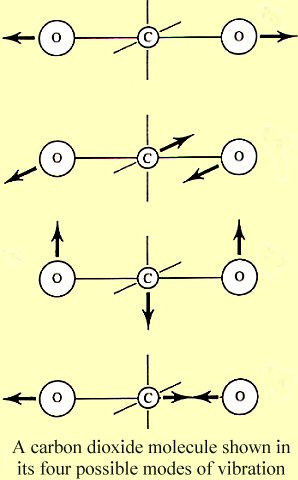Carbon Dioxide
Today, carbon dioxide and energy. The University of Houston's College of Engineering presents this series about the machines that make our civilization run, and the people whose ingenuity created them.
A carbon atom can combine with either one or two atoms of oxygen. Carbon monoxide is pretty reactive. It readily burns in oxygen to create carbon dioxide, or CO2. CO2 is completely stable. It won't burn, and you can breathe it all day with no ill effects. You do breathe carbon dioxide, all the time.

The major component of any fossil fuel is carbon. It forms seventy-five percent of methane, the major component of high-grade natural gas. Carbon forms eighty-four percent of octane, which typifies most gasolines. It forms eighty percent of good anthracite coal.
Now here's the catch. Since each carbon atom joins with two heavier oxygen atoms, CO2 molecules are much heavier than the carbon in fuels. Each pound of fuel yields almost three pounds of CO2. That takes some digesting. Our first reaction is, "It's only a gas; it surely can't amount to much." But each gallon of gasoline produces twenty pounds of carbon dioxide.
Our consumption of fossil fuels has now caused the CO2 content of Earth's air to be higher than it should be. It's certainly impacting our climates. How much is subject to a pretty fierce debate, but global temperatures are definitely on the rise. While better analysts than I try to determine exactly what part of the rise comes from CO2 greenhouse effects, we'd be crazy not to look for ways of reducing the CO2 in our air.
We leave it to plants to turn carbon dioxide back into burnable carbon and oxygen. So far, lowered fuel consumption seems to be the only answer to increased CO2 levels. Cleaning up emissions won't get rid of it. And the only way to avoid producing it is to quit burning carbon. But now I find a set of odd new technologies in a recent Mechanical Engineering magazine.
These are means for collecting CO2 and storing it away much as we do with nuclear waste. One trick is to gather in CO2, compress it, and pump it into the ocean bottom, where the pressure holds it in liquid form. As a liquid, it's much heavier than water and will stay on the bottom. A plant in the North Sea is presently burying 2800 tons of CO2 in the ocean every day. That's roughly the output of a big 140-megawatt coal-fired power plant.
Another process converts CO2 into a solid carbonate. The product is a brick that's one-fifth CO2. The bricks are still far too expensive to be practical, but they get me thinking. While I worry about these so-called sequestering methods taking carbon out of circulation, they might just offer a temporary stay -- as we keep hesitating to use nuclear and renewable energy.
In any case, my aim today is modest. I just want to offer CO2 as a contemplation object -- a focus for our thoughts as we continue the ongoing struggle with rising energy demands and the terrible problems they bring with them.
I'm John Lienhard, at the University of Houston, where we're interested in the way inventive minds work.
(Theme music)
J. Winters, Carbon Underground. Mechanical Engineering, Vol. 25, No. 2., February 2003,pp. 46-48.
